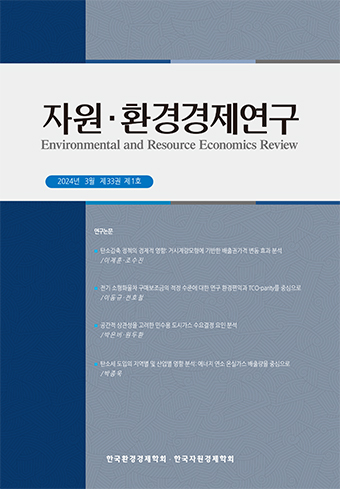Research Paper
Abstract
References
Information
Using the Choice Experiment Method, this paper identified whether subsidy to the household around landfil in Seoul metropolitan area is being provided corresponding to the scale of the environmental damage. Since 2001, the subsidy program has been operating for nearly 20 years to compensate for various environmental damage (foul odor, noise, air pollution, water pollution, etc.) from landfill site in the metropolitan area, but it is not clear on what ground the subsidy is allocated. This paper estimated the marginal WTP by attribute (odor, noise, air pollution, and water pollution) based on mixed logit model and compared them with current subsidy level per household in each town. As a result of the comparison, it was found that the subsidy for each town was not allocated in proportion to the amount of the marginal WTP for each household in the corresponding town. In addition, this paper constructs a level-by-level scenario for environmental improvement attributes and compares economic benefits and current subsidy levels. As a result, the current subsidy level is insufficient compared to the level at which environmental damage is completely eliminated, but excessive subsidy is allocated compared to partial improvement levels.
본 논문은 선택실험법(Choice Experiment Method)을 이용하여 현행 지원되는 수도권매립지 주변 주민에 대한 주민지원금이 피해 정도에 상응하게 지원되고 있는지를 파악하였다. 2001년부터 거의 20년 가까이 운영된 주민지원금은 수도권매립지 운영에서 발생하는 다양한 환경피해(악취, 소음, 대기오염, 수질오염, 경관훼손 등)를 보상하기 위한 목적에서 운영되고 있으나, 현행 보상의 정도가 주변 지역 주민의 실제 피해 비용만큼 보상이 이뤄지고 있는 파악할 수 없다. 이에 본 논문은 수도권매립지 부지 경계 기준 주변 2~4km에 거주하는 주민들 300명을 대상으로 선택실험법 설문을 한 결과를 이용하여 혼합로짓모형(Mixed logit model)을 통해, 동(읍)별로 속성(악취, 소음, 대기오염, 수질오염)별 한계지불의사액을 추정하고, 이를 현행 동(읍)별 가구당 주민지원금과 비교하였다. 이를 기반으로 시나리오를 구성하고 전체 그리고 지역별 가구당 피해비용(지불의사액)을 추산하여 2019년 전체 그리고 지역별 주민지원금과 비교한 결과, 현행 전체 주민지원금 규모는 수도권매립지 주변 주민이 받는 전체 환경피해를 완벽하게 제거되는 수준에 미치지 못하는 것으로 평가되었으며, 지역별 주민지원금의 배분도 해당 지역별 피해 정도에 비례하여 배분되지 못하고 있다는 것을 발견하였다.
- 강희찬, “헤도닉가격모형을 이용한 수도권매립지 유발 비효용 감소에 대한 지불의사액 추정”, 「자원․환경경제연구」, 2020, 제29권 3호, pp. 335~362.
- 국립환경과학원(2019.11.18.), 인천 사월마을 주민건강영향조사 주민설명회 개최, 보도자료.
- 국토교통부, 『2018년 주거실태조사 결과』, 2019.
- 김광임, “쓰레기 매립자 기피의사 추정: 수도권 매립장의 사례”, 「자원경제학회지」, 제5권 제2호, 1996, pp. 303~315.
- 수도권매립지공사(2020), 『2019 수도권매립공사 통계연감 제18호』.
- 에어코리아 www.airkorea.or.kr
- 인천서구, 동별 주민등록인구 및 세대현황 (http://www.gimi9.com/dataset/data-incheon-go-kr-3043877)
- 환경부, 『수도권매립지 환경상 영향조사 결과보고』, 2004.
- 환경부, 『수도권 생활폐기물 반입총량제 이행현황 중간 점검결과』, 2020.
- Blore, I, and F. Nunan, “Living with waste: public valuation of solid waste impacts in Bangkok,” Papers in the Administration of Development No. 57. University of Birmingham, Birmingham, UK: Development Administration Group, 1996.
- Bouvier, R. A., J. M. Halstead, K. S. Conway, and A. B. Manalo, “The Effect of Landfills on Rural Residential Property Values: Some Empirical Analysis,” Journal of Regional Analysis and Policy, Vol. 30, No. 2, 2000, pp. 23~37.
- Gaglias, A., S. Mirasgedis, C. Tourkolias and E. Georgopoulou, “Implementing the Contingent Valuation Method for supporting decision making in the waste management sector,” Waste Management, Vol. 53, 2016, pp. 237~244.10.1016/j.wasman.2016.04.012
- 27114113
- Garrod, G and K. Willis, “Estimating lost amenity due to landfill waste disposal,” Resources, Conservation and Recycling, Vol. 22, 1998, pp, 83~95.10.1016/S0921-3449(97)00046-3
- Greene, W. H., Economctric Analysis, 5th Edition, New York University, Prentice Hall, 2000.
- Karousakis, K., and E. Birol, “Investigating household preference for kerbside recycling services in London: A choice experiment approach,” Journal of Environmental Management, Vol. 8, 2008, pp. 1099~1108. 10.1016/j.jenvman.2007.05.015
- 17658678
- Kiel, K. A., “Measuring the Impact of the Discovery and Cleaning of Identified Hazardous Waste Sites on House Values,” Land Economics, Vol. 71, No. 4, 1995, pp. 428~435. 10.2307/3146708
- Krinsky, I., and A. L. Robb, “On Approximating the Statistical Properties of Elasticities,” Review of Economic and Statistics, Vol. 68, 1986, pp. 715~719.10.2307/1924536
- Kroll, E. B., and B. Vogt, The relevance of irrelevant alternatives, Economics Letters, Vol. 115, No. 3, 2012, pp. 435~437.10.1016/j.econlet.2011.12.124
- McFadden D., Conditional Logit Analysis of Qualitative Choice Behavior, Frontiers in Econometrics, New york, Academic Press, 1974.
- Pek, C. K., and O. Jamal, Solid Waste disposal: A Choice experiment Experience in Malaysia, Munich Personal RePEc Archive, 2009.
- Preez, M. D., “Determining the negative effect on house values of proximity to a landfill site by means of an application of the hedonic pricing method,” South African Journal of Economic and management Science, No. 2, 2009.
- Ready, R, C., “Do Landfills Always depress nearby property values?,” Rural Development Paper, No. 27, 2007.
- Sacratees, J., and G. Govindaraj, ‘Estimating Economic Costs of Municipal Solid Waste Management: Using Contingent Valuation Method’, Urganization in Asia, Springer, pp. 179~197.10.1007/978-81-322-1638-4_11
- Sasao, T.(2004), “Analysis of the socioeconomic impact of landfill siting considering regional factors”, Environmental Economics and Policy Studies, Vol. 6, No. 2, pp. 147~175.10.1007/BF03353935
- Tarfasa, S., and R. Brouwer, “Public preference for improved urban waste management: a choice experiment,” Environment and Development Economics, Vol. 23, 2018, pp. 184~197. 10.1017/S1355770X17000432
- Publisher :Environmental and Resource Economics Review
- Publisher(Ko) :자원 · 환경경제연구
- Journal Title :자원·환경경제연구
- Journal Title(Ko) :Environmental and Resource Economics Review
- Volume : 30
- No :3
- Pages :365-393
- DOI :https://doi.org/10.15266/KEREA.2021.30.3.365



 자원·환경경제연구
자원·환경경제연구






